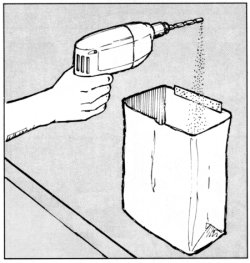SPLINTERS
Tennessee Valley Woodworkers
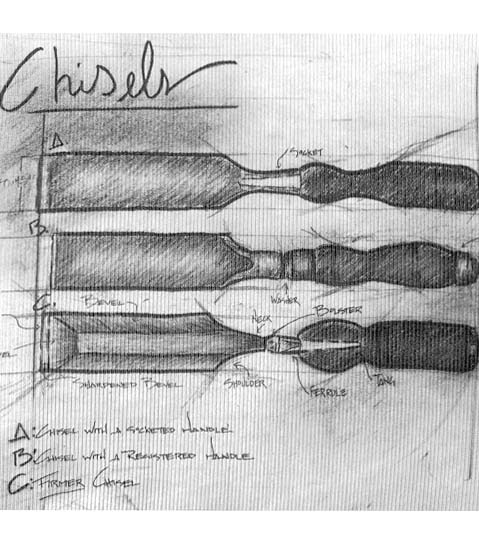 Vol. 17/ Issue 4
April 2002
Editor: Tom Gillard Jr.
Vol. 17/ Issue 4
April 2002
Editor: Tom Gillard Jr. 

Meeting Notice:
The next meeting of the TN Valley Woodworkers
Will be held, April 16th at 7:00 p.m. in the
Duck River Electric Building, Dechard, TN
All interested woodworkers are invited!


The following people have agreed to serve as contacts for their particular
skills. If you have questions, suggestions
for activities, or other comments relating to these skills, please
call these folks. Their interest is to help the
club better serve their area of expertise. Your participation
with them will help them achieve that goal.
Alice
Berry 454-3815 Design
Phil Bishop
967-4626 Finishing
Tom
Church 967-4460 Turning
Harry May
962-0215 Carving
Bob
Reese 728-7974 Sharpening
Ross Roepke
455-9140 Joinery
Maurice Ryan 962-1555
Health and Safety
List of
Club Officer
President: Bob Leonard
V. President: Doyle McConnell
Secretary: Barbara Keen
Treasurer: Henry Davis
Publicity: Maurice & Ruth Ryan
Newsletter Editor: Tom Gillard Jr.
GOD BLESS AMERICA!

CALENDAR of EVENTS
Spring seminar: April 20th @ Foothills
Craft, Manchester
Picnic: June 22nd @ Falls
Mill
Coffee County Fair : 3rd week in September
Fall seminar :October time frame
Christmas party: December 6
** It was also suggested that we should have another “turning B” and
possibly another carving workshop.
The seminar theme will be finishing and refinishing, and it will be
held at the classroom at Foothills Craft building in Manchester.
The time will be from 9:00 AM with a break for lunch at one of the local
restaurants. It will end somewhere around 3 PM.
The presenter will be David Duggin from Woodbury. David is an antique
dealer who does his own finishing.
The cost will be $20.
Come and let's have a good time.
SHOW AND TELL:
*Don Powers brought in a turned vase.
*Phil Bishop showed us 1 of the supports he is making for a Granite
Counter top. He carved, bandsawed and used the router on it.
They are made out of Alder.
*Tom Gillard Jr. showed us a sailboat tiller made out of salvaged teak.
*Jim Van Cleave told us about a museum in Winston Winston-North Carolina
that had 30 rooms of period furniture. He brought in a large bowl
and a bird feeder he made and another one that someone else made that was
an example of how not to make a working bird feeder.
*Jim Parker brought in cherry legs that he made. He said he drew
the legs out on 2 sides of a squared block of wood and than band sawed
them. He than put in lathe and cut foot and than finished shaping
with a rasp and spoke shave.
*Loyd Ackerman brought turned walnut bowls.
*Doyle Mc Connell brought in a goblet he made and finished with beeswax.
He also brought in a picture frame that he made with an upturned angle.
He had problems because of the upturn angle holding for gluing and finally
used hot glue to put on temporary blocks that he could clamp. He
used lacquer finish.
Steve Shores made a jig for holding tools while sharpening.
*Billy Mays showed us a carved elephant out of Tupelo and he finished
with Johnson floor wax. He also made a Dolphin out of basswood with
a black walnut base.
*Ken Clark brought in a bandsaw box that he got out of Wood issue 51.
He used cherry stain on it and floor wax.
*Chuck Tayor brought in a bowl he started at the turning “ b” which
was cherry with a lacquer finish and he also showed a natural edge bowl
made out of Red Bud.
*Herald Hewgley brought in a chair, which was a copy of an antique.
It was made out of Cherry and finished with Valspar Satin Black finish.
He sprayed 4 light coats.
*Ken Gould made a lathe bench for his new lathe. He also did
the black smith work on the Iron straps. It was cherry with 2 coats
of cherry stain and 2 coats of Deft oil.
*Jim Kemp showed us a Myrtlewood pencil holder he had made.
April Meeting
Loyd will be presenting the program next month on "Wood
movement as it Effects Joinery". (<---click
there)This will fit in with our joinery theme this year very well.
Loyd has done a lot of work in this area and as always I am sure that it
will be well presented.
-Doyle
--------------------------------------------------------------
"I just wanted to say that this was my first time to be a part of a seminar
of this sort, since I started with American Saw. I truly enjoyed
the time I could spend with you all. I'm sure I speak for Ray Hughes,
Glenn Tetro, and Doug Walston with Precision Blade when I say that, organizations
like yours are an asset to any community."
Thank you for your time.
Sincerely,
Mark Gomez
NAME TAGS
The subject of name tags came up at the last meeting. Our name tags
were made by K&S TROPHIES , 510 Country Club Drive , Tullahoma.
They were about $5.00 including tax the last time we checked. When in Tullahoma
you can go by and have one made. The tags are 1" x 3" with white letters
on a blue background. Just tell the folks that you want a Tennessee Valley
Woodworkers name tag. If you are never in Tullahoma, Henry Davis will be
happy to take care of it for you, see him at the February meeting or give
him a call at 393 - 3191.
Mini Lathe Give Away.
To show our appreciation to our loyal and faithful members your Executive
Committee has again this year decided to give a prize to one lucky member.
To be eligible to win the lathe just sign the drawing register at each
regular club meeting that you attend between now and December. That means
that if you attended the January meeting and attend every meeting from
now through November your name will be in the drawing 11 times.
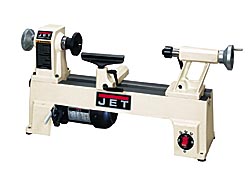
Staves and Segments
Staved or segmented construction figures in a lot of projects, from ornamental
bowl turnings to porch pillars. A question we often hear is: What miter
angle (or bevel) do I need? Another recurring question is: How long (or
wide) should I make the pieces? Finding those answers is relatively easy.
Here’s how to do the math. 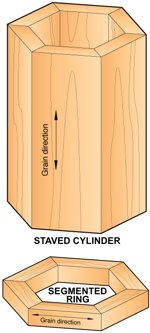
First, let's get our terminology straight.
Staved cylinders and segmented rings may seem alike, but they're two different
breeds of cats. As shown in the Staved Cylinder and Segmented Ring illustrations,
the individual pieces in a segmented ring are miter-cut (shown in the Segment
illustration) and joined at the ends. In a staved cylinder, the component
parts are bevel-cut (shown in the Stave illustration) and joined edge-to-edge.
So, things can become confusing when we start talking about the distance
between the angles. On a stave that distance is the width, but on a segment,
it's the length. For this article, we'll refer always to length. Substitute
width" if you're cutting staves. 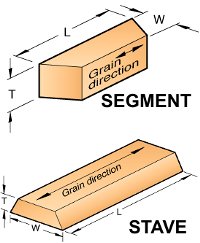
Also for simplicity, we'll call the angled cuts miters, even
though we know they may be either miters or bevels. Note, too, that this
article only covers straight-sided cylinders or flat rings. Tapered cylinders
or rings with sloped sides call for compound cuts.
Corner and miter angles for various numbers of
sides
|
no. of sides
|
corner
|
miter
|
|
6
|
60°
|
30°
|
|
8
|
45°
|
22-1/2°
|
|
10
|
36°
|
18°
|
|
12
|
30°
|
15°
|
|
16
|
22-1/2°
|
11-1/4°
|
What's your angle?
A full circle contains 360°. So, to make a closed construction
out of straight pieces, the corner angles must add up to 360°. In the
simple figure with six equal-length sides shown in the Corner and Miter
Angle illustration below, the six 60° corners add up to 360°. But,
as shown, 60° is not the angle you need to cut on the ends of each
piece. Because two sides come together to make the angle, each side must
be miter-cut to exactly half the total corner angle, or 30°.
Here's the rule for finding the angle:
To determine the corner angle for a figure with any number of equal-length
sides, divide 360° by the number of sides. To find the miter angle,
divide the corner angle by two.
How big will it be?
To figure out the measurement across the assembled construction, shown
as D1 in the Assembled Size illustration, multiply the side length (L)
times the inside-diameter factor for the appropriate number of sides from
the chart below. This dimension, which is the diameter of the largest circle
that can be drawn inside the outline of the glue-up, also represents the
diameter of the largest round piece that could be sawn or turned from the
assembled ring. You can calculate the width across the points, shown
as D2, by multiplying the side length times the outside-diameter factor.
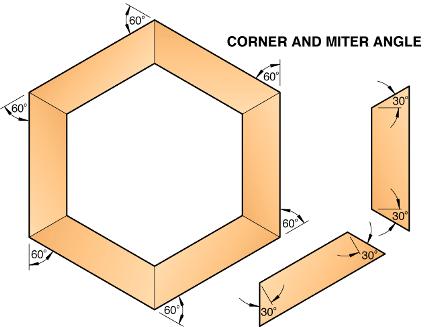
FACTOR TO FIND DIAMETER
Diameter
|
no. ofsides
|
inside (D1)
|
outside (D2)
|
|
6
|
1.73205
|
2
|
|
8
|
2.41421
|
2.61313
|
|
10
|
3.07768
|
3.23607
|
|
12
|
3.73205
|
3.86370
|
|
16
|
5.02734
|
5.12583
|
And if you need to know the diameter of the opening in a ring, shown
as D3, just multiply the length of the short edge of the segment (IL) by
the appropriate inside-diameter factor. You can work backwards, too,
to find the stave length required to produce a given diameter. In this
case, divide the desired diameter by the factor from the chart. To find,
for instance, the side length for a hexagon that measures 24" across (D1),
divide 24" by the inside-diameter factor (1.73205). Doing this gives us
13.85641", or 13-55/64".
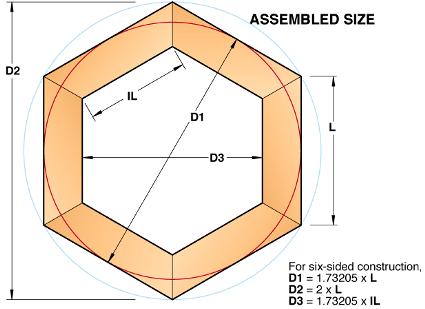
MONTHLY DRAWING: We had our monthly drawing and the following people won
Ray Cole honing blocks, Tom Mc Gill hearing protection, Tom Gillard maglite
, Jim Roy long drill bits, and Gary Hoyle a maglite.
The Fair Maidenhair-tree
Ginkgo biloba is known as a "living fossil tree". This tree's
genetic line spans the Mesozoic era back to the Triassic period.
Closely related species are thought to have existed for over 200 million
years.
Also known as maidenhair-tree, the leaf shape and other vegetative organs
are identical to fossils found in the United States, Europe and Greenland.
Today's contemporary ginkgo is cultivated and does not exist anywhere
in the wild state. Scientists think that native ginkgo was destroyed
by glaciers that ultimately covered the whole Northern Hemisphere.
Ancient Chinese records are surprisingly complete and describe the tree
as ya-chio-tu, meaning a tree with leaves like a duck's foot. Asian
people systematically planted the tree and many living ginkgoes are known
to be more than 5 centuries old. Buddhists not only kept written
records but revered the tree and preserved it in temple gardens.
Western collectors eventually imported ginkgoes to Europe where it was
very popular in large cities like London and Paris.
G. biloba was first brought into the United States by William Hamilton
for his garden in Philadelphia in 1784. It was a favorite tree of
Architect Frank Lloyd Wright and made its way into city landscapes across
North America. The tree had an ability to survive pests, drought,
storms, ice, city soils, and was widely planted. But it did have
a problem...
Stink-bomb Tree
The ginkgo is dioecious. That simply means that there are separate
male and female plants. Only the female plant, when fertilized, produces
the oval, slimy, tan-orange ginkgo fruit. The fruit stinks!
The smell's description ranges from "rancid butter" to "vomit".
This foul smell has limited ginkgo's popularity while also causing city
governments to actually remove the tree and ban the female from being planted.
Male ginkgoes do not produce a fruit and are selected as the main cultivars
used to transplant in urban communities.
The slippery pulp can also be a liability. Because of potential
city sidewalks slimed with the pulp of the fruit, urban landscapers recommend
only the male tree. Some of the best varieties found to plant are
'Autumn Gold', 'Princeton Sentry' and 'Fairmont'.
Thanks for the Memories
The extract of ginkgo biloba is bottled as a remedy for several ailments.
Maidenhair-tree's leaf extract is a billion dollar business. According
to one recent report, "In Germany alone, ginkgo biloba prescriptions (it
is prescribed by doctors in Germany) retailed at $280 million in U.S. dollars".
A German manufacturer, Schwabe, sold almost $2 billion U.S. dollars worth
of Ginkgo biloba extract worldwide in 1993.
Gingko biloba is most effective as a concentrated extract, found in
either liquid or tablet form. It has beneficial effects on the circulatory
system, particularly among the elderly. Studies have shown it can help
in treatment of their short-term memory loss, headache, tinnitus (ringing
in the ears) and depression by improving blood flow in the arteries and
capillaries (ask you doctor before trying any new remedies)
Fascinating Facts
* There are no native ginkgoes living in the wild.
All wild trees were wiped out over a million years ago but human intervention
has saved the modern tree.
* Several ginkgoes were the only living survivors
of an atomic bomb blast dropped on Hiroshima by the United States.
* About 50 pounds of dried ginkgo leaves yield a
pound of the medicinal product.
Sacking a mess before it becomes one
Drilling holes in wall paneling,
especially drywall, leaves
unsightly particles on the wall
and the floor, fine dusty material
that's tough to clean up.
TIP: Tape an open paper bag to
the wall a few inches below
where you plan to drill. Once that
bit starts chewing and spitting out
nasty particles, they will fall right
into the sack. When finished
drilling, simply pull loose the
masking tape, and toss away a mess that never happened.
—Earl Hagen, Livonia, Mich.

WEB
SITES of INTEREST
Precision Blade and Tool
Scott
Phillips Video Help sessions
Arrowmont
School of Arts and Craft
WOOD
ONLINE newsletter
Falls Mill
Appalachain
Center for the Arts
Forest
Products Lab. 1999 Wood Handbook
Woodworker's
Journal
TN Association Woodturners
WOOD
Online TVWW page
Kevin's Woodturnings
The Oldham Company
The Woodworker's Choice
Russell Brown's Web Page


Saw Blade Sharpening Services: Branching Out is now offering their
services as a drop off spot to have your saw blades sharpened. The
blades will be picked up (Tuesdays), sharpened, and dropped back off at
Branching Out. The Leitz Tooling Systems out of Collierville, TN
will do the sharpening. Call (393-0525) or stop by for details.
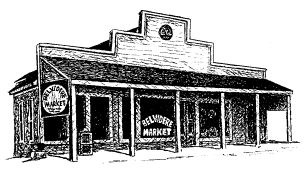
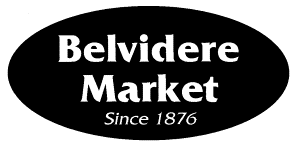
10 % OFF Fine Woodworking
Books from Taunton Press
…We’re open Monday thru Saturday
Webmaster:
Tom Gillard Jr.

 Vol. 17/ Issue 4
April 2002
Editor: Tom Gillard Jr.
Vol. 17/ Issue 4
April 2002
Editor: Tom Gillard Jr. 
![]()
![]()
![]()






